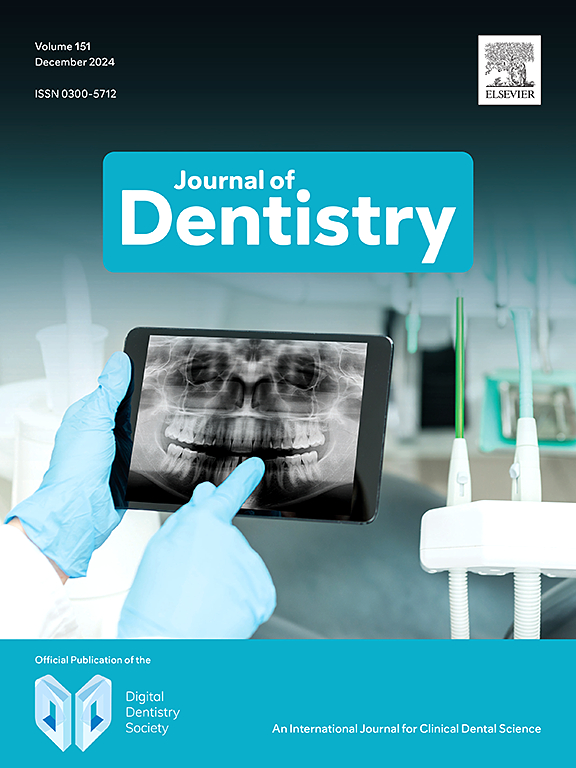与减法制造的基台相比,对不同制造方向的加成法制造的两件式氧化锆基台的制造精度和内部配合进行评估。
IF 4.8
2区 医学
Q1 DENTISTRY, ORAL SURGERY & MEDICINE
引用次数: 0
摘要
目的与使用 3 mol% 和 4 mol% 钇稳定氧化锆(3Y-TZP 和 4Y-TZP)减法制造的两件式氧化锆基台相比,评估构建方向对制造真实性和密合性的影响:使用扫描体和工业扫描仪对钛基台(Ti-base)进行数字化处理,设计出具有 50 µm 骨水泥间隙的两件式氧化锆基台。利用该设计以加法生产不同方向的氧化锆基台(0 度,AM-0;15 度,AM-15;30 度,AM-30;45 度,AM-45;180 度,AM-180),并以减法生产 3Y-TZP 和 4Y-TZP 基台(SM-3 和 SM-4)(n=5)。使用口内扫描仪对所有基台进行数字化处理,包括基台在钛基底上的情况,以及仅对钛基底进行数字化处理的情况。基台的真实度(整体、外部、凹内和边缘)用均方根(RMS)法进行分析,其密合度用三重扫描协议进行评估。数据分析采用单因素方差分析和 Tamhane's T2 检验(α = 0.05):结果:SM-3 基台的整体和外部 RMS 最低(P ≤ 0.023)。SM-3和SM-4基台的内侧RMS大多较低,而AM-0基台的龈侧RMS大多较低(P≤0.013)。除了AM-0和SM-3(P≥0.930),SM-4基台的平均间隙最小(P≤0.041):结论:SM-3 基台大多具有较高的加工真实度,而 AM-0 基台的真实度与其他添加剂制造的基台相似或更高。AM-0、SM-3 和 SM-4 基台的配合度相似,平均间隙低于 50 µm。本文章由计算机程序翻译,如有差异,请以英文原文为准。
Evaluation of the fabrication trueness and internal fit of additively manufactured two-piece zirconia abutments with different build orientations compared to subtractively manufactured abutments
Objective
To evaluate the effect of build orientation on the fabrication trueness and fit of additively manufactured 2-piece zirconia abutments when compared with those manufactured subtractively in 3 mol% and 4 mol% yttria-stabilized zirconia (3Y-TZP and 4Y-TZP).
Methods
A titanium-base (Ti-base) abutment was digitized with a scan body and an industrial scanner to design a 2-piece zirconia abutment with a 50 µm cement gap. This design was used to manufacture zirconia abutments additively in different orientations (0-degree, AM-0; 15-degree, AM-15; 30-degree, AM-30; 45-degree, AM-45; 180-degree, AM-180) and subtractively from 3Y-TZP and 4Y-TZP (SM-3 and SM-4) (n=5). An intraoral scanner was used to digitize all abutments, when they were seated on the Ti-base, and only the Ti-base. Abutments’ trueness (overall, external, intaglio, and marginal) was analyzed with the root mean square (RMS) method, and their fit was assessed with the triple-scan protocol. Data were analyzed with 1-way analysis of variance and Tamhane's T2 tests (α = 0.05).
Results
SM-3 abutments had the lowest overall and external RMS (P ≤ 0.023). SM-3 and SM-4 abutments mostly had lower intaglio and AM-0 abutments mostly had lower gingival RMS (P ≤ 0.013). Except for AM-0 and SM-3 (P ≥ 0.930), SM-4 abutments had the lowest average gaps (P ≤ 0.041).
Conclusions
SM-3 abutments mostly had higher fabrication trueness, while AM-0 abutments had trueness similar to or higher than the other additively manufactured abutments. AM-0, SM-3, and SM-4 abutments had similar fit with average gaps lower than 50 µm.
求助全文
通过发布文献求助,成功后即可免费获取论文全文。
去求助
来源期刊

Journal of dentistry
医学-牙科与口腔外科
CiteScore
7.30
自引率
11.40%
发文量
349
审稿时长
35 days
期刊介绍:
The Journal of Dentistry has an open access mirror journal The Journal of Dentistry: X, sharing the same aims and scope, editorial team, submission system and rigorous peer review.
The Journal of Dentistry is the leading international dental journal within the field of Restorative Dentistry. Placing an emphasis on publishing novel and high-quality research papers, the Journal aims to influence the practice of dentistry at clinician, research, industry and policy-maker level on an international basis.
Topics covered include the management of dental disease, periodontology, endodontology, operative dentistry, fixed and removable prosthodontics, dental biomaterials science, long-term clinical trials including epidemiology and oral health, technology transfer of new scientific instrumentation or procedures, as well as clinically relevant oral biology and translational research.
The Journal of Dentistry will publish original scientific research papers including short communications. It is also interested in publishing review articles and leaders in themed areas which will be linked to new scientific research. Conference proceedings are also welcome and expressions of interest should be communicated to the Editor.
 求助内容:
求助内容: 应助结果提醒方式:
应助结果提醒方式:


